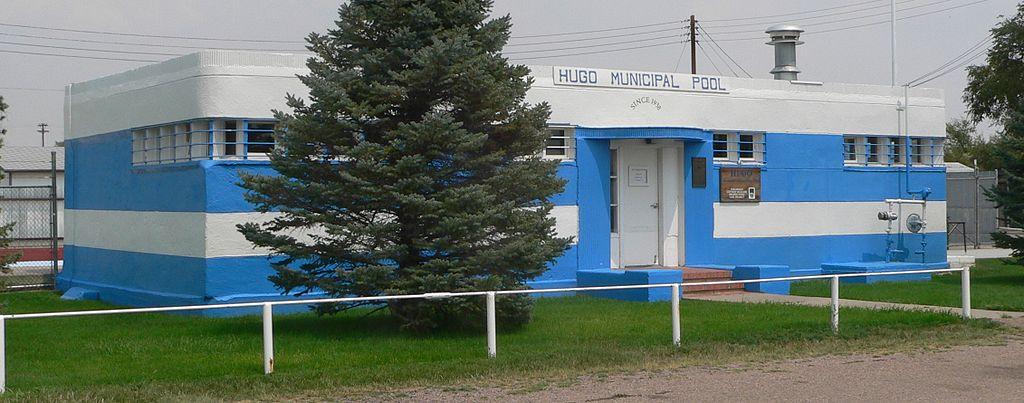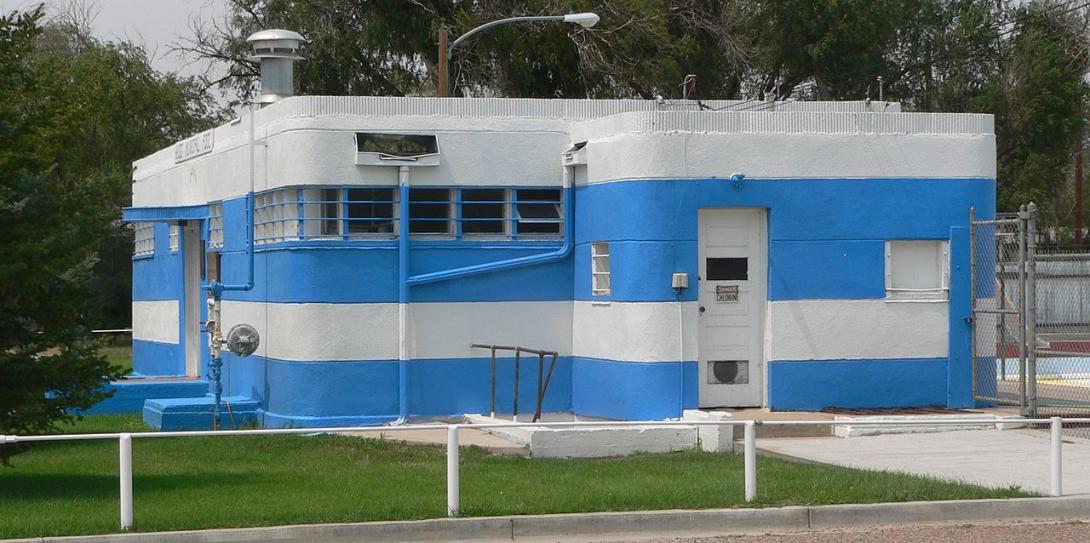Hugo Municipal Pool
Full Article
Located at the corner of Fourth Street and Sixth Avenue in Hugo, the Hugo Municipal Pool was built in 1936–38 as a Works Progress Administration (WPA) project designed to provide employment and improve quality of life during the Great Depression. The pool’s bathhouse is notable for combining a traditional construction technique—adobe blocks—with modern design. The community continues to use the pool every summer, and in 2008 it was listed on the National Register of Historic Places.
Building the Pool and Bathhouse
As in the rest of eastern Colorado, the Great Depression and the Dust Bowl caused tremendous hardship in Hugo. New Deal programs like the WPA helped soften the blow by providing employment opportunities and building public amenities. Pool projects were popular in eastern Colorado—more than ten were built under the WPA—but only Hugo’s pool and bathhouse are still intact and in use today.
In September 1935 the town of Hugo submitted a WPA project proposal for a pool and bathhouse. At the time, Hugo had no parks or other recreational facilities, so a pool would help improve the local quality of life. In addition, because the pool would be on Fourth Street—the main thoroughfare along which US 40 and US 287 passed through Hugo—the town hoped it might get travelers to stop and spend some money.
The project was approved almost immediately, but it had a long path to completion. Funding did not come through until May 1936. Construction started in September, but then stopped in January 1937 so that the crew could assist with construction of the Hugo Gymnasium. Work on the pool and bathhouse resumed in April, but in July the crew was again called off the project to help fight a plague of grasshoppers.
All these stops and starts meant the town had to submit a second project application in May 1938 to secure funding to complete the bathhouse and an adobe wall around the pool. The application was approved, and the pool opened to the public on June 18, 1938, even though the bathhouse and wall were not quite finished. Adults could swim for a quarter, children for a dime. Swimmers could rent bathing suits and towels, and lifeguards offered free swimming lessons. Average daily attendance during the pool’s first summer in operation was 165.
The pool and bathhouse were designed by district WPA engineer Lloyd E. Heggenberger. The bathhouse, like Heggenberger’s other projects, had a modernist design. In this case the style was WPA Art Moderne, with a flat roof, rounded corners, and horizontal bands of windows that curved around the corners. Despite the modern design, the building used a traditional construction method—adobe blocks—in order to minimize the cost of materials and maximize the money spent on labor. Inside, the bathhouse had a central desk and office with the men’s dressing room to the left and the women’s to the right. Each dressing room had its own door that led out to the pool.
Today
The pool and bathhouse have seen relatively few alterations. Probably the most noticeable is that the bathhouse was entirely white when it opened but has now been painted with two horizontal blue stripes. Other changes have involved repairing adobe structures that suffered water damage. Originally a five-foot adobe wall surrounded the pool, but it suffered water damage and was replaced with a metal fence in 1960. In addition, much of the adobe used for the bathhouse’s exterior walls suffered water damage over the years and has been replaced with concrete blocks. In 1987 a concrete deck was poured around the pool.
The Hugo Municipal Pool continues to be used every summer and is still an important recreational facility for local residents.















